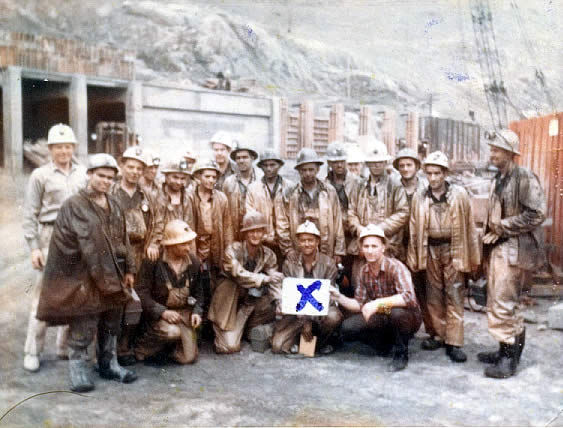Granduc Mine

History - Continued
Photo - These Miners drilled the main tunnel
By 1956, the existence of extensive copper orebodies at the Granduc mine had been established. To develop these orebodies, a decision was made in 1964 to drive the 11.5-mile tunnel from the Leduc mine site on the west side of Granduc Mountain to the proposed site of concentrator facilities at Tide Lake in the Bowser River Valley and to construct a road from the mill at Tide Lake to Stewart at which deep-sea port facilities could be established.
The driving of the haulage tunnel is one of the major engineering feats in the history of mining and is the subject of a separate article in this issue. The story of the avalanche which descended on the Leduc camp has been told many times and is well known to the mining men of this continent. Its immediate effect from an engineering point of view was to alter the original two-heading concept to that of a single drive from the Tide Lake portal. This was a most severe setback and it delayed completion of the program a full year.
The fact remains that ore was being mined, transported through the world's longest mining-operation tunnel, and was being treated in a modern concentrator; that the campsite at the Tide Lake end of the tunnel was fully developed; that housing for married personnel has been established at Stewart where deep-sea loading facilities have also been constructed; and that Granduc had become a major force in Canadian mining and was a notable contributor to the provincial and federal economies as well as a substantial employer of labor.
The Granduc mine was leased to Granduc Operating Company which was owned jointly by Newmont Mining Corporation and American Smelting and Refining Company. The two major companies participate equally in the joint venture and Granduc Operating Company was the operator . Under the terms of the lease, Granduc Mines, Limited, was to receive a royalty of 22.5% of operating profits earned from the first 32.5 million tons milled and a royalty of 25% thereafter. The operators, who provided all of the funds, quoted a figure of $115 million as the expenditure from October I, 1965, to bring the property to the production stage. It can only be concluded, in consideration of the hazards herein mentioned and the always uncertain fluctuations of metal markets, that this was "risk capital" with a vengeance. It can also serve as a reminder to the socio-economists of our age, who tend to deride achievement, that more than dreams are needed to realize the attainment of a good life; that it is still left to those with sheer "guts" to proceed with the financing of such a project and to re-affirm their confidence in the face of rising costs and physical stoppages; that much depends on our technical people with their undiminished competence ...all working together to make our economy function and to make Canada, as has been done so many times in the past, something of a better place in which to live. Published ore reserves at Granduc were estimated at more than 43,000,000 tons grading I. 73% copper with minor values in gold and silver.
NEXT DISCOVERY